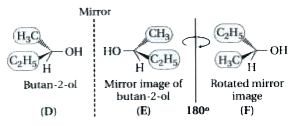Explain the following terms :
Chiral centre (atom) and Achiral molecule Solution in Gujrati
Chiral centre : A sp3 atom bonded with four different groups is called chiral centre or chiral different groups is called chiral centre or chiral atom.
J. Van.t Hoff and C. Le Bel independently argued that the spatial arrangement of four groups around a central atoms of a carbon is tetrahedral and if all the substituents attached to that carbon are different, the mirror image of the molecule is not superimposed on the molecule. Such a carbon is called asymmetric carbon or stereocentre.

Note : The presence or absence of chiral atom is not criteria for a molecule to be optically active. The optical activity is due to molecular asymmetry (Chirality). However, a molecule with one chiral centre is always optically active.
The molecule that lacks a symmetry are called achiral molecules. These are optically inactive.

Propan-2-ol (A) does not contain an asymmetric carbon, as all the four groups attached to the tetrahedral carbon are not different. The mirror image (B) when rotated by 180∘ gets completely overlap on (A) and (C ).
Topper's Solved these Questions
- BOOK - KUMAR PRAKASHANCHAPTER - HALOALKANES AND HALOARENESEXERCISE - SECTION - B INTEXT QUESTIONS AND ANSWERS20videos
HALOALKANES AND HALOARENES
- BOOK - KUMAR PRAKASHANCHAPTER - HALOALKANES AND HALOARENESEXERCISE - SECTION - C TEXTUAL EXERCISE87videos
HALOALKANES AND HALOARENES
- BOOK - KUMAR PRAKASHANCHAPTER - HALOALKANES AND HALOARENESEXERCISE - SECTION - E Multiple Choice Questions260videos
HALOALKANES AND HALOARENES
- BOOK - KUMAR PRAKASHANCHAPTER - GENERAL PRINCIPLES AND PROCESSES OF ISOLATION OF ELEMENTSEXERCISE - SECTION - E (MCQs ASKED IN GUJET/BOARD EXAMS)46videos
GENERAL PRINCIPLES AND PROCESSES OF ISOLATION OF ELEMENTS
- BOOK - KUMAR PRAKASHANCHAPTER - POLYMERSEXERCISE - SECTION - E (MCQs asked in Board Exams)51videos
POLYMERS
Similar Questions
Write the structures of the following compounds :
2-Chloro-3-methylentaneView SolutionName the following halides according to IUPAC system and classify them as alkyl, allyl, benzyl (primary, secondary, tertiary), vinyl or aryl halides :
(CH3)2CHCH(Cl)CH3View SolutionThe derivatives that are not found in nature are …..
02:27View SolutionDuring electrolysis of aqueous solution of Na2SO4 using graphite electrode .........
02:27View SolutionWhich polymer is used in preparation of capsules ?
03:37View SolutionReactions involving stereoisomers
To study the involvement of stereoisomers in chemical reactions we shall take up following points:
(i)The conversion of an achiral molecule into a chiral molecule, with the generations of a chiral centre.

Secondary butyl chloride exist as two enantiomers but mixture is optically inactive due to formation of a racemic mixture.Both enantiomers are obtained in equal amounts.Racemic mixture is an eqnimolar mixture of two enantiomers.
(ii)Conversion of chiral molecule into chiral and achiral molecules.

Which of the following reactant will give chiral products on monochlorination ?05:57View SolutionReactions involving stereoisomers To study the involvement of stereoisomers in chemical reactions we shall take up following points: (i)The conversion of an achiral molecule into a chiral molecule, with the generations of a chiral centre. Secondary butyl chloride exist as two enantiomers but mixture is optically inactive due to formation of a racemic mixture.Both enantiomers are obtained in equal amounts.Racemic mixture is an eqnimolar mixture of two enantiomers. (ii)Conversion of chiral molecule into chiral and achiral molecules. Monochlorination of which of the following will give only an achiral products ?
03:52View SolutionDifferentiate between chiral and achiral molecules.
01:08View SolutionDifferentiate between chiral and achiral molecules.
01:40View SolutionClassify the following objects as chiral or achiral:
(iii) a spoon02:40View SolutionClassify the following objects as chiral or achiral:
(iv) a cup04:53View SolutionClassify the following objects as chiral or achiral:
(v) hand02:59View SolutionCHBrCIF has "chiral" // "achiral" carbon atom.
03:31View SolutionCHBrCIF has "chiral" // "achiral" carbon atom.
04:31View SolutionExplain the following terms : Chirality
03:24View Solution

